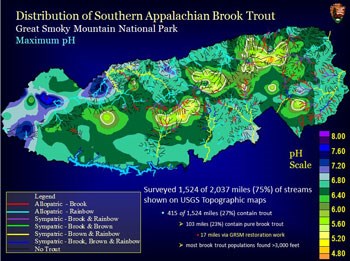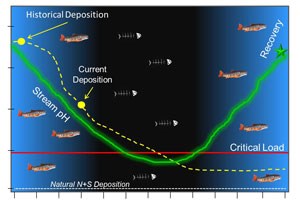
Greg Shafer photo Introduction
In 2006, the Tennessee Department of Environmental Conservation listed 12 of Great Smoky Mountains National Park's streams on the 303(d) list due to having mean stream pH (a measure of acidity) lower than 6.0 (TDEC 2010;Neff et al. 2009). This indicated that the streams listed were unsuitable for their designated use for protection of wildlife and recreation. These levels of acidity are particularly detrimental as pH approaching 5-5.5 is unsuitable for trout species as well as other native fish in the park (Baker et al. 1996).
What is the Cause of High Acidity? Acid deposition is the introduction of compounds that increase the acidity of an environment. While many people have heard of acid rain, or wet deposition, the prevalent form of deposition in the park is from the settling of air particles onto the soils in the park during dry periods. This process is called dry deposition (Zhou et al. 2014). These particles are widespread as a result of the prevalence of coal-fired power plants and automobiles. Due to many soils lacking the ability to absorb and neutralize these acids, many of these compounds eventually end up in the parks streams (Neff et al. 2013).

How Much Deposition Can the Park Handle?
A collaborative project between the National Park Service, engineers from Syracuse University, and The University of Tennessee was conducted in order to determine the maximum amount of deposition which can be received without having harmful effects to park biota, or the critical loads (Total Maximum Daily Load/ TMDL), of the compounds (Nitrate and Sulfate) which are responsible for the majority of acid deposition. The study modeled deposition using water quality data collected by the University of Tennessee, Trout Unlimited volunteers, and the National Park Service. The model was used to create a hindcast or an estimate of historical levels and to predict the response to increases or decreases of deposition in the future. Results suggest that if there is no change in atmospheric deposition then the acid neutralizing capacity (ANC) of the watersheds of the park as well as the pH of streams will continue to decrease. According to the model, in order to increase the ANC of the watershed in question to levels which are suitable for trout, both Sulfate and Nitrate must be reduced. The current rate of deposition is 0.6 keq/ha-yr to 3.2 keq/ha-yr. In order to increase the ANC of all test sites to 0 microeq/L by 2050, the model indicates deposition should be decreased to 1keq/ha-yr (Zhou et al. 2014).

It is part of the National Park Service's mission to preserve and protect the quality of all resources within the parks. However, when the NPS is faced with problems such as the atmospheric deposition of acids, which are created outside of the park itself, it is difficult if not impossible for the NPS alone to resolve the problem. By establishing a TMDL for the streams in the parks, important information is provided to our partners, which allow states to develop air quality controls in order to help preserve park streams and surrounding areas (TDEC 2010). For more information, visit the following links:
Prepared by Nathaniel Hancock.
Works Cited
Baker, J.P., J. Van Sickle, C.J. Gragen, D.R. DeWalle, W.E. Sharpe, R.F. Carline, B.P. Baldigo, P.S. Murdoch, D.W. Bath, W.A. Krester, H.A. Simonin and P/J. Wigington, Jr. 1996. Episodic acidification of small streams in the northeastern United States: effects on fish populations. Ecological Applications: 422-437.
Neff, K.J., Schwartz, J.S., Henry, T.B., Robinson, R.B., Moore, S.E., and Kulp, M.A. (2009). Physiological stress in native southern brook trout during episodic stream acidification in the Great Smoky Mountains National Park. Arch. Environ. Contam. Toxicol. 10.1007/s00244-008- 9269-4: 57, 366–376.
Neff, K., Schwartz, J., Moore, S., & Kulp, M. (2013). Influence of basin characteristics on baseflow and stormflow chemistry in the Great Smoky Mountains National Park, USA. Hydrological Processes, (27), 2061-2074. doi:10.1002/hyp.9366
TDEC (2010). Proposed Total Maximum Load (TMDL) for low pH in the Great Smoky Mountains National Park located in the Pigeon River Watershed (HUC 06010106) Lower French Broad River Watershed (HUC 06010107) Watts Bar Lake Watershed (HUC 06010201) Cocke and Sevier County, Tennessee (Prepared by Tennessee Department of Environment and Conservation Division of Water Pollution Control).
Zhou, Q., C. T. Driscoll, S. E. Moore, M. A. Kulp, J. R. Renfro, J. S. Schwartz, and M. Cai. 2014. Developing critical loads of nitrate and sulfate deposition to watersheds of the Great Smoky Mountains National Park, United States. Natural Resource Technical Report NPS/GRSM/NRTR—2014/896. National Park Service, Fort Collins, Colorado.
|
Last updated: August 7, 2015
